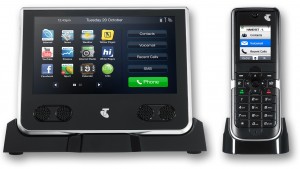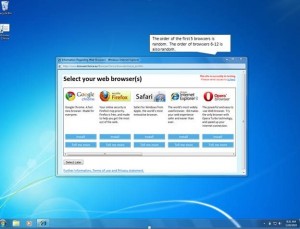What was the common household telephone?
The household telephone became common during the years of prosperity that occurred after World War II ended and technology made it affordable for most householders to have a telephone service. This was a telephone handset that was installed in a common area of the house like a kitchen, hall, main lounge room or dining room. This phone, which was initially black, was allocated a number by the monopoly telephone provider and family, friends, employers and neighbours of any of the household’s members knew this number to contact the household’s members. These same members could place calls from that phone or receive calls on it whenever anybody who knew the number rang in. Sometimes it was seen as part of the wedding celebrations for a married couple to list their names in the standard telephone directory as “<husband’s first name> & <wife’s first name> <surname>”.

Using a common household telephone in the kitchen
There wasn’t the expectation of privacy from other members of the household during a phone call and, in a lot of cases, whenever the phone rang, members of the household would be “on edge” if the call was for them or not and whether the call had anything to do with them or not. If the intended call recipient wasn’t available, it was the job of whoever answered the phone to write down any messages that the caller may leave and, in some cases, call out those messages to the intended recipient. Typically this involved making sure there was a notepad or message book and a working pen near the phone and there were may occasions where there would be frustration due to the pen that was meant to be near the phone going missing. This has led to companies manufacturing pens that are tethered to a holder that is attached to the phone.
There used to be the option of having extra phone sockets installed around a house so you could move the phone amongst particular locations. On the other hand, some households installed an extra phone in the master bedroom, home office or similar locations so they could make or take calls from these locations. One person whom I know who used to run a dairy had 4 or 5 phones with three in the main living area, one in the office and another in the bedroom so he could take milk orders as soon as possible.
The cordless phone, which became popular through the 1980s and the 1990s, had changed the dynamics of the common household telephone and had allowed for some privacy and for handling calls in one’s preferred location.
This was the way with telephony for everyone until the 1990s when the mobile phone became affordable for most people due to competing service providers, subsidised handsets and prepaid mobile services. Similarly, there are many households with two or more lines where another of the lines is used as a household member’s private line because of the cost of telephone service going downhill.
What is now happening with the common household telephone
The mobile phone has made the common household telephone less relevant for engaging in personally-sensitive calls because the person can give out their own mobile phone number for such calls and can take these calls in their bedroom or outside with their mobile phone. Therefore these phones just end up being used for calls where there aren’t any privacy expectations.
In some households, especially share-houses with many young people, there isn’t a common household telephone installed. Instead, the phone line is used primarily for Internet access or other data-based activity. In other households, the common household telephone is simply seen by adults and teenagers as a failover line or a “call-anyone” line for that household.
The reduced traffic on these lines due to the mobile phone and VoIP-based low-cost-calling services has made the telecommunications companies (telcos), especially incumbent telcos who traditionally provided this service, worried because of the loss of call revenue that these lines yield. Some of these companies who run Internet or mobile services make up for this loss through the revenue derived from these services, but they have to maintain the infrastructure that is part of this elementary phone service.
The arrival of the sophisticated multi-function telephone
Now electronics manufacturers and telcos are developing implementations of the sophisticated multifunction home telephone. These are Internet-connected telephone devices which have a regular phone handset or cordless phone unit, but have a large colour touchscreen for many different purposes. Examples of these include Telstra’s “T-Hub” cordless phone with touchscreen base and the DSP Group’s Android-driven Wi-Fi cordless phone that looks like a smartphone.

Telstra T-Hub cordless multifunction telephone
The main driver behind the arrival of these terminals is the arrival of “single-pipe triple-play” fixed-location communications services which encompass Internet, landline telephony and multichannel television. These phones are being pitched as a more-sophisticated alternative to connecting a regular telephone to the Internet gateway device and using that device’s analogue telephony adaptor as the VoIP on-ramp.
These phones are able to work as a landline SMS terminal, email terminal and gateway to the popular social-networking Websites. A lot of them will have a general Web browser that works in a similar manner to how one browses the Web on a smartphone. Some of them will be able to play streamed or downloaded audio and video material with the sound coming out of a speaker that would normally be used for speakerphone applications; and the vision appearing on the phone’s touchscreen. It may also include the ability to use content held on local storage or network storage. These features are being used as a justification for replacing the phone that was placed in the kitchen or other common area because of their relevance to that area.
The phones that are part of a VoIP-based setup will also offer functionality not dissimilar to that of a business phone system with such call-handling functions like call transfer and park, conference calling, free intercom calling and the like. Some operators who sell the classic switched-circuit phone services will also offer hybrid VoIP-switched-circuit services with VoIP providing extra sophisticated functionality and a switched-circuit as a fallback.
Individualised communications
Another trend that is shaping the role of the common household telephone is the concept of individualised communications. This has started off with mobile telephones and businesses signing up to “direct-inward-dial” numbers for their staff members, but is now being made real with VoIP-based landline telephony services. It was also augmented with the idea of locale and device-independent “personal” telephone numbers being made available to people.
Here, a VoIP-based landline telephony system could allow users to determine which phone will ring and in what way (tone or cadence) if a particular personal number is called. This may be achieved through an interactive “log-on” routine that the user performs when they want to use that phone. It may also allow for individualised call accounting including the concept of “own telephone account”, which may be useful for households with teenagers, lodgers or small businesses.
In the same context, users who already maintain their own mobile phones could annexe these phones in to a VoIP-based landline telephone system that supports individualised communications and elect to make or take calls from the system’s phones or their mobile phone with connection-appropriate charging taking place to their account.
Action being taken to standardise these concepts
The Home Gateway Initiative is a trade group who are establishing reference standards for network hardware for the home and small business. They have established a reference standard for home network gateway devices like the routers, but more so the Internet gateway devices that have integrated VoIP functionality. They have also looked at the device setup scenarios where there are external modems like most cable Internet setups, but will encompass next-generation Internet setups. They are working on reference standards for VoIP telephony and could end up determining such standards for the multi-function telephones.
Conclusion
If these companies can look at ways of extending value out of the common household telephone by integrating it in today’s online world, they could stand a chance at seeing it more than just a communications device for the sidelined communities.




 I had
I had 